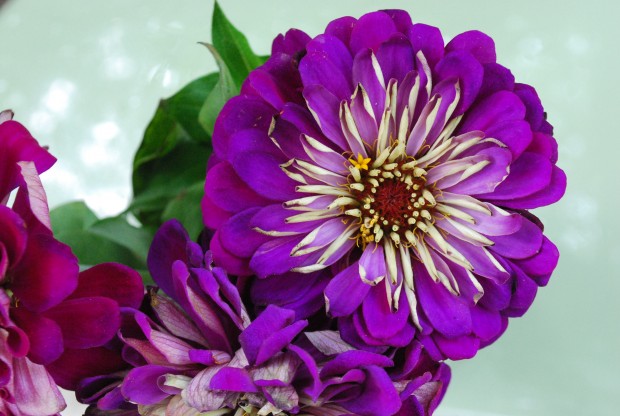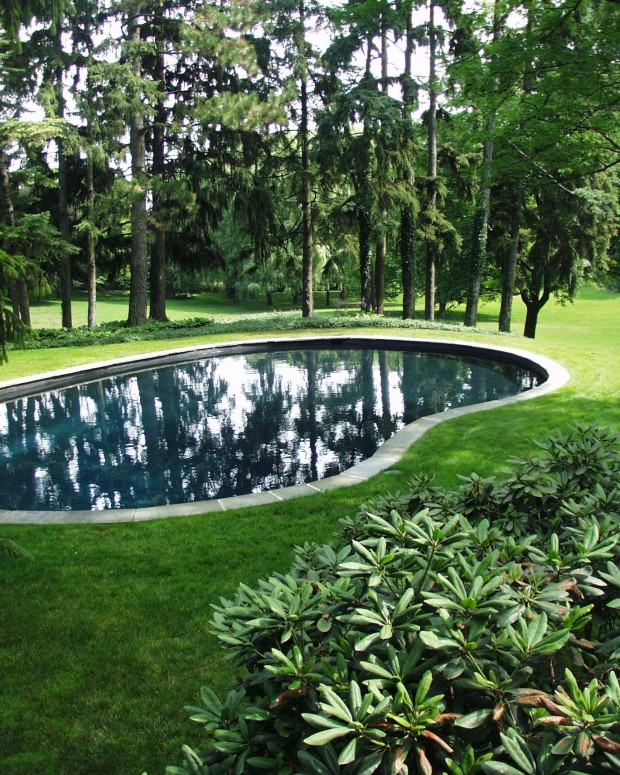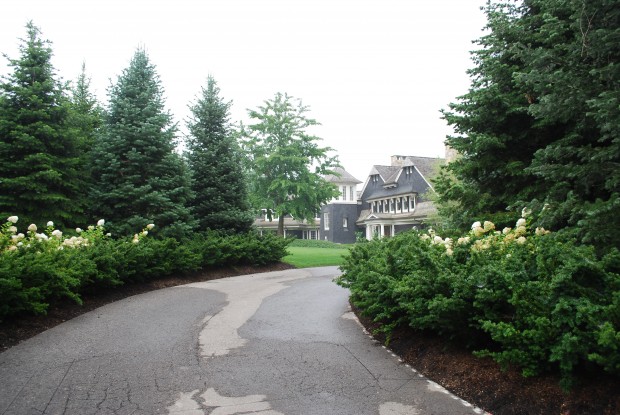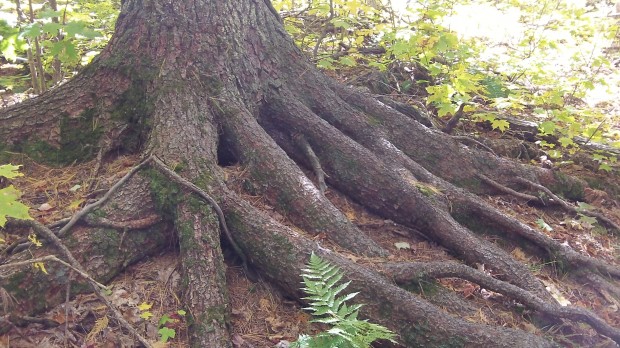A memory can be triggered by many things. The smell of lilacs in the spring. The fragrance of a rose. A mass of daisies, blooming. Plants that bring memories flooding back to me mostly have to do with my mother’s garden. Roses-oh yes, so many roses. A gingko tree, grown from seed to a spectacular size. Tomatoes, lettuce, and herbs in pots. Orchids, hanging from the trees. And the zinnias she grew from seed. I never see a zinnia without thinking of her.
But my memories of her aside, the big old evergreen trees that it has been my pleasure to meet make me feel zero at the bone. Zero at the bone? A feeling which is primeval. Elemental. For me, giant old trees evoke memories that are not tied to specific events. They may provoke memories of which I am only dimly aware.
I am sure this sense of belonging to the primeval forest is why it is so difficult to take down a big tree. Even a damaged or sick old tree. This client was very attached to a pair of old and weary Norway spruce planted just a few feet from the foundation of the house. Taking them down was not an option. Planting more of them at the road, a fitting tribute. I always admired her reluctance to interfere with with a chain saw. The landscape had an aura that would not have been possible without those old trees.
These trees may be many years away from evoking a memory of the primeval forest, but the impulse was there to plant them.
Giant old trees whose life spans many gererations of people are as rare in urban areas as they are revered. Old large properties that have never been clear cut to make way for neighborhoods provide homes for old trees. The steward-gardener who takes great pains to look after them is a person for whom those trees evoke a memory. In my area, there are old cemeteries whose old trees are spectacular. Many cities have parks, and for good reason. Exposure to an old, natural or archetypal landscape is comforting, and thought provoking.
The Estivant Pines nature sanctuary on the Kewenaw Peninsula in the upper peninsula is a protected home to many old pines. Pictured in the Michigan Nature Association blog, this is the trunk of one of the largest and oldest of those pines. The preservation of these old trees is the result of the work, patience and determination of many-all of whom have a memory that is important to nurture.
This post is but one of many featured at the Garden Designer’s Roundtable today on the subject of memory and plants. My special congratulations to Andrew Keys, whose book Why Grow That When You Can Grow This has just been published on this very topic. If the book is as exuberant and sassy as he is, it should be a great read!
Andrew Keys : Garden Smackdown : Boston, MA
Genevieve Schmidt : North Coast Gardening : Arcata, CA
Jocelyn Chilvers : The Art Garden : Denver, CO
Lesley Hegarty & Robert Webber : Hegarty Webber Partnership : Bristol, UK
Mary Gallagher Gray : Black Walnut Dispatch : Washington, D.C.
Rebecca Sweet : Gossip In The Garden : Los Altos, CA
Susan Cohan : Miss Rumphius’ Rules : Chatham, NJ
Susan Morrison : Blue Planet Garden Blog : East Bay, CA
Thomas Rainer : Grounded Design : Washington, D.C.
Rochelle Greayer : Studio ‘g’ : Boston, MA






Great post. There is something particularly evocative about old trees. In the DC area, the combination a rare summer derecho and this month’s Hurricane Sandy has really done a number to so many legacy trees in parks and private landscapes. The area actually looks different than it did a year ago. It’s made me quite aware of how true this post is. Thomas
Thomas, legacy trees-what a beautiful way to put it. I wanted to write more about archetypal landscapes-but quickly realized I was over my head. Old trees-everyone knows what they mean with no need for explanation. Deborah
Old souls. We have walked among them for centuries and they are part of our collective beings. They can make me cry when I stand next to them. I feel a need for silence (prayer or reverence?) and seldom take them down even as you say ‘Even an damaged or sick old tree.’
It is heartbreaking, sickening when an old tree has to come down, or when a storm takes it down.
Deborah: nice to connect with the UP of MI. I was there in Sept. with our older daughter hiking in Porcupine Mtns State Pk. Wonderful to be among those ancient hemlock. Afraid their days, and so many of the old pines, are numbered due to climate change. We must get out there, enjoy them while we can and plant good, heat tolerant substitutes. Great post. Douglas
Thasnks for writing, Douglas. My father’s family all lived in the UP. I spent a lot of time there as a child. In Cedarville Michigan, where most of my relatives lived, the smell of cedar was everywhere-I can still conjure up that smell. Deborah
This post resonated with me. When we are standing next to a tree that was here when the Declaration of Independence was signed, or — like with a Bristlecone Pine out West — when Christ walked the earth, that is pretty profound. It’s as if the trees themselves are the ones with the memory, and we are very small and very fleeting indeed.
Dear Mary, You put it far better than I ever could. Thanks, Deborah
A gardener friend on the east coast recently confessed to me she was afraid that the damage Hurricane Sandy caused was going to encourage people to foolishly cut down their trees now to minimize future risk. I certainly hope she is wrong, but in my own design practice, I am surprised at how many clients perceive trees as simply a future headache to be avoided. What is so magical about an unobstructed view of a golf course? And after all, doesn’t everything worth having – friends, family, pets – involve a healthy dose of heartache and maintenance?
I do my best to counsel and or persuade. If I bat better than 500, I am pleased. I have yet to meet the client who dislikes trees-for this I am grateful.
I’m so glad your clients opted to keep the two Norway spruce, and it takes a caring designer to recognize their importance. Bravo for you! And love the term ‘zero to the bone’ – a new one for me and after googling it I find out it’s from one of my favorite poets – Emily Dickinson!
Thanks for the reference-I had no idea where the phrase zero at the bone came from.
I agree completely, Deborah, and especially as someone who first connected with plants as a child in the woods. This speaks a bit to what Thomas said in his post too. Have you guys ever read Donald Peattie’s books on trees?
(Thank you for the mention too!)
Thomas’ post was so detailed-loved it. I am not familiar with Donald Peattie-I’ll look it up. My time to read is February. Looking forward to reading your new book then too-congratulations on that! You so deserve a mention-maybe more.
That house with the flanking Norway spruces — I’d never have wanted them there, but seeing the picture, there IS something immensely evocative, like an enchanted cottage in the woods. I found your focus on old trees very moving.
Odd I put on a CD of Gregorian Chants as I read this post! That 3rd photo resonates to me the most, and if I lived where we had forests, I would be similar about trees. Here, most trees over 30′ tall were only planted to get quick shade, regardless of water use or life span…all dying. I guess I’m that way about smaller plants or plant stands that don’t have a chance when a freeway is widened – I still recall before such things happened in my 21 years here – what I was doing at the time, or who I was with.